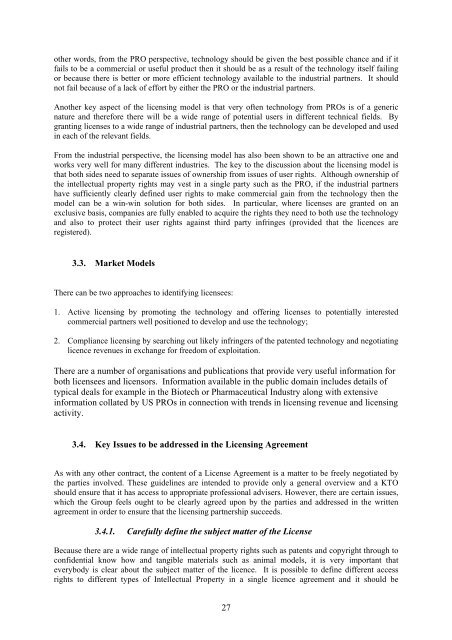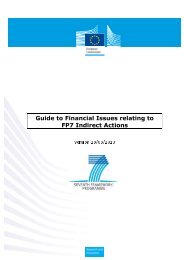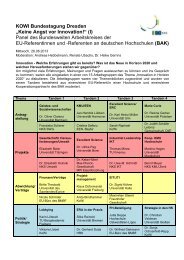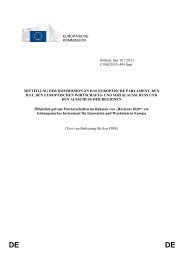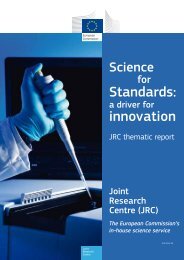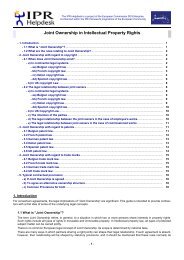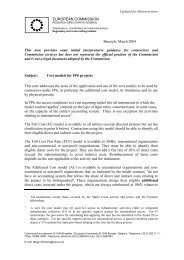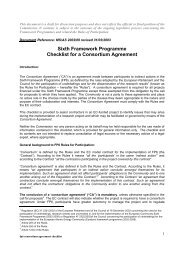Expert Group Report Management of Intellectual Property in ... - KoWi
Expert Group Report Management of Intellectual Property in ... - KoWi
Expert Group Report Management of Intellectual Property in ... - KoWi
You also want an ePaper? Increase the reach of your titles
YUMPU automatically turns print PDFs into web optimized ePapers that Google loves.
other words, from the PRO perspective, technology should be given the best possible chance and if it<br />
fails to be a commercial or useful product then it should be as a result <strong>of</strong> the technology itself fail<strong>in</strong>g<br />
or because there is better or more efficient technology available to the <strong>in</strong>dustrial partners. It should<br />
not fail because <strong>of</strong> a lack <strong>of</strong> effort by either the PRO or the <strong>in</strong>dustrial partners.<br />
Another key aspect <strong>of</strong> the licens<strong>in</strong>g model is that very <strong>of</strong>ten technology from PROs is <strong>of</strong> a generic<br />
nature and therefore there will be a wide range <strong>of</strong> potential users <strong>in</strong> different technical fields. By<br />
grant<strong>in</strong>g licenses to a wide range <strong>of</strong> <strong>in</strong>dustrial partners, then the technology can be developed and used<br />
<strong>in</strong> each <strong>of</strong> the relevant fields.<br />
From the <strong>in</strong>dustrial perspective, the licens<strong>in</strong>g model has also been shown to be an attractive one and<br />
works very well for many different <strong>in</strong>dustries. The key to the discussion about the licens<strong>in</strong>g model is<br />
that both sides need to separate issues <strong>of</strong> ownership from issues <strong>of</strong> user rights. Although ownership <strong>of</strong><br />
the <strong>in</strong>tellectual property rights may vest <strong>in</strong> a s<strong>in</strong>gle party such as the PRO, if the <strong>in</strong>dustrial partners<br />
have sufficiently clearly def<strong>in</strong>ed user rights to make commercial ga<strong>in</strong> from the technology then the<br />
model can be a w<strong>in</strong>-w<strong>in</strong> solution for both sides. In particular, where licenses are granted on an<br />
exclusive basis, companies are fully enabled to acquire the rights they need to both use the technology<br />
and also to protect their user rights aga<strong>in</strong>st third party <strong>in</strong>fr<strong>in</strong>ges (provided that the licences are<br />
registered).<br />
3.3. Market Models<br />
There can be two approaches to identify<strong>in</strong>g licensees:<br />
1. Active licens<strong>in</strong>g by promot<strong>in</strong>g the technology and <strong>of</strong>fer<strong>in</strong>g licenses to potentially <strong>in</strong>terested<br />
commercial partners well positioned to develop and use the technology;<br />
2. Compliance licens<strong>in</strong>g by search<strong>in</strong>g out likely <strong>in</strong>fr<strong>in</strong>gers <strong>of</strong> the patented technology and negotiat<strong>in</strong>g<br />
licence revenues <strong>in</strong> exchange for freedom <strong>of</strong> exploitation.<br />
There are a number <strong>of</strong> organisations and publications that provide very useful <strong>in</strong>formation for<br />
both licensees and licensors. Information available <strong>in</strong> the public doma<strong>in</strong> <strong>in</strong>cludes details <strong>of</strong><br />
typical deals for example <strong>in</strong> the Biotech or Pharmaceutical Industry along with extensive<br />
<strong>in</strong>formation collated by US PROs <strong>in</strong> connection with trends <strong>in</strong> licens<strong>in</strong>g revenue and licens<strong>in</strong>g<br />
activity.<br />
3.4. Key Issues to be addressed <strong>in</strong> the Licens<strong>in</strong>g Agreement<br />
As with any other contract, the content <strong>of</strong> a License Agreement is a matter to be freely negotiated by<br />
the parties <strong>in</strong>volved. These guidel<strong>in</strong>es are <strong>in</strong>tended to provide only a general overview and a KTO<br />
should ensure that it has access to appropriate pr<strong>of</strong>essional advisers. However, there are certa<strong>in</strong> issues,<br />
which the <strong>Group</strong> feels ought to be clearly agreed upon by the parties and addressed <strong>in</strong> the written<br />
agreement <strong>in</strong> order to ensure that the licens<strong>in</strong>g partnership succeeds.<br />
3.4.1. Carefully def<strong>in</strong>e the subject matter <strong>of</strong> the License<br />
Because there are a wide range <strong>of</strong> <strong>in</strong>tellectual property rights such as patents and copyright through to<br />
confidential know how and tangible materials such as animal models, it is very important that<br />
everybody is clear about the subject matter <strong>of</strong> the licence. It is possible to def<strong>in</strong>e different access<br />
rights to different types <strong>of</strong> <strong>Intellectual</strong> <strong>Property</strong> <strong>in</strong> a s<strong>in</strong>gle licence agreement and it should be<br />
27


